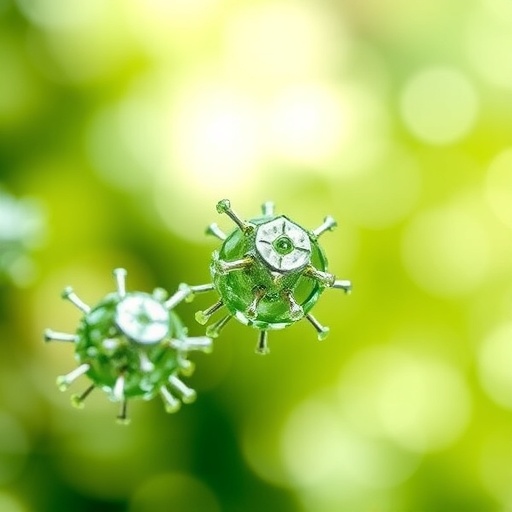In a groundbreaking study led by researchers Hamze, Z.K., Assi, S., and Mhanna, R., the sustainable production of multifunctional green silver nanoparticles has emerged as a promising approach to tackle environmental pollution and public health challenges. As the global community faces increasing threats from industrial waste and bacterial infections, the timely development and application of innovative solutions have never been more crucial. This research synthesizes the compelling attributes of green silver nanoparticles, heralding a new era in clean technology focused on the degradation of dyes and the inhibition of bacterial growth.
Silver nanoparticles have garnered significant attention in recent years for their remarkable properties and diverse applications in medicine, environmental remediation, and agriculture. With the synthesis route being vital to their effectiveness, the researchers employed environmentally friendly methods that utilize natural resources, aligning their work with sustainable development goals. By minimizing toxic byproducts, this approach not only reduces the ecological footprint of nanoparticle production but also enhances their potential for future industrial applications.
The study meticulously outlines the methodology for synthesizing these nanoparticles, employing green chemistry principles. Plant extracts, rich in phytochemicals, serve as reducing agents and stabilizers, ensuring that the resulting silver nanoparticles are both effective and non-toxic. This natural synthesis route promises an array of benefits, including cost-effectiveness and scalability, making it an appealing option for commercial manufacturers looking to innovate while adhering to sustainability benchmarks.
Through a series of controlled experiments, the research team demonstrated the efficacy of the synthesized silver nanoparticles in catalyzing the degradation of various dyes commonly found in industrial effluents. Dye pollution is an ever-growing concern, particularly in regions with significant textile manufacturing industries. The results of this study underscore the nanoparticles’ ability to break down complex dye molecules, transforming them into less harmful constituents, ultimately leading to cleaner water sources.
The multifunctional capabilities of these green silver nanoparticles extend beyond dye degradation. Their potent antibacterial properties position them as formidable agents against a spectrum of bacterial strains. As antibiotic resistance rises to alarming levels worldwide, the need for alternative antibacterial strategies has become paramount. The research findings suggest that these nanoparticles could potentially act as a viable solution in both medical and sanitation applications, presenting an innovative path forward in combating rising public health threats.
Understanding the mechanisms behind the disinfection properties of silver nanoparticles reveals fascinating insights into their interactions with bacterial cells. The researchers identified that the nanoparticles disrupt bacterial membranes, leading to cell lysis and death. This finding provides a compelling basis for further exploration into the use of silver nanoparticles in various biomedical applications, including wound dressings, coatings for medical devices, and water purification systems.
Furthermore, this research significantly contributes to the growing body of literature that supports green nanotechnology. By laying out a clear methodology that emphasizes the importance of sustainability in the production of nanoparticles, the study sets a precedent for future research endeavors. It encourages scientists and industrial stakeholders to adopt environmentally benign methods that do not sacrifice efficacy for ecological mindfulness.
As this innovative research gains traction, it is essential to consider the broader implications of integrating green silver nanoparticles into existing systems. Industrial sectors could greatly benefit from the adoption of these nanoparticles in wastewater treatment facilities, leading to a sharp reduction in toxic discharges into the environment. This transition aligns with global sustainability initiatives that advocate for the responsible management of resources and the reduction of ecological footprints.
Moreover, the promising characteristics of these nanoparticles can enhance agricultural practices, notably in crop protection and soil health. By exploring the antagonistic interactions between these nanoparticles and plant pathogens, researchers can possibly formulate eco-friendly solutions that support sustainable farming techniques, contributing to food security in a growing global population.
In addition to ecological and agricultural applications, the clinical implications are equally compelling. As concerns regarding antibiotic resistance escalate, alternative therapeutic approaches are critical. The adoption of green silver nanoparticles could potentially reshape treatment methodologies, offering a novel adjunct in the fight against resistant bacterial strains, thus enhancing patient outcomes significantly.
The study conducted by Hamze and colleagues is not just an academic exercise; it represents a tangible shift towards sustainable practices across sectors. It embodies the spirit of innovation that is necessary to address the multifaceted challenges posed by pollution and public health threats. As more researchers and industries rally around the principles outlined by this study, a transformational wave of eco-friendly solutions is on the horizon.
In conclusion, the sustainable preparation of multifunctional green silver nanoparticles delineated in this research is a testament to the harmony that can exist between technological advancement and environmental stewardship. By leveraging natural resources, the study reveals pathways that could lead to significant breakthroughs in pollution mitigation, health care, and agricultural sustainability. The alignment of these nanoparticles’ properties with pressing global challenges illustrates the potential that lies in responsible scientific inquiry and the visionary pursuits of innovative researchers.
As communities worldwide seek sustainable solutions to pervasive issues, the model presented in this study can serve as an inspiring template. The momentum generated by these findings could spark greater interest in green nanotechnology, ensuring that future advancements not only prioritize efficacy but also safeguard our planet’s precious resources.
Subject of Research: Sustainable preparation of multifunctional green silver nanoparticles for environmental remediation and health applications.
Article Title: Sustainable preparation of multifunctional green silver nanoparticles for efficient catalytic dye degradation and bacterial inhibition.
Article References:
Hamze, Z.K., Assi, S., Mhanna, R. et al. Sustainable preparation of multifunctional green silver nanoparticles for efficient catalytic dye degradation and bacterial inhibition.
Environ Sci Pollut Res (2025). https://doi.org/10.1007/s11356-025-36950-y
Image Credits: AI Generated
DOI: 10.1007/s11356-025-36950-y
Keywords: green silver nanoparticles, sustainable synthesis, environmental remediation, catalytic dye degradation, antibacterial properties, green nanotechnology, public health, waste treatment, agricultural sustainability, antibiotic resistance.




